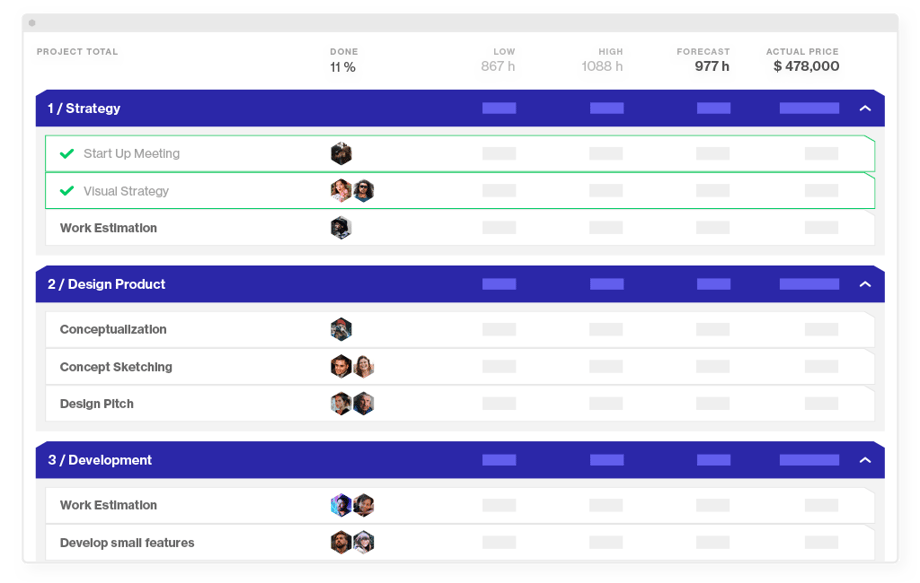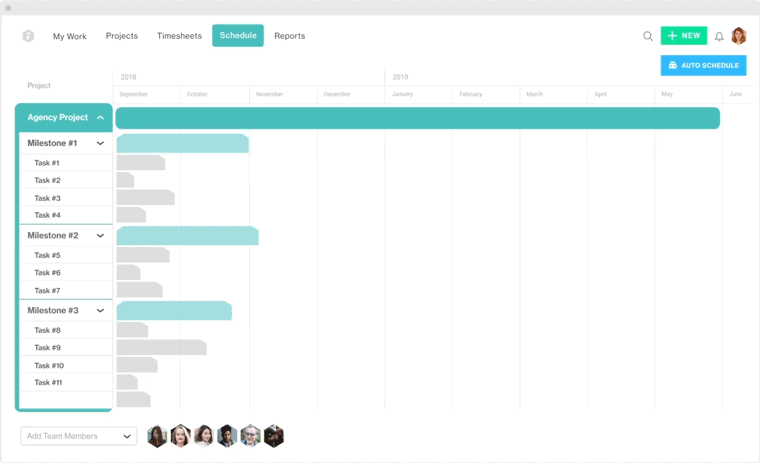Project Cost Estimation Made Simple: Definition, Techniques & Best Practices

"We need to price this new project for a client", your sales representative says.
"Great! Let's get a grasp of this project by figuring out what needs to be done", you say and start calculating a cost estimate. But project cost estimation is not pure math. It is a complex process that involves input from the client and putting your heads together with the team as well as the perfect understanding of feature priorities, business value, nice-to-haves, and so on.
At the same time, organizations globally waste an average of $114 million for every $1 billion spent, poor requirements gathering and management being one of the top causes of project failure. So how can you manage all of this in a consistent manner? We’ve got a guide for everyone who wants to become better at estimating costs for a project and solve the problem of budget overrun.
- What is project cost estimation?
- Why project cost estimation is important
- Factors involved in project cost estimation
- Common project cost estimation techniques
- Prime reasons for inaccurate project cost estimates
- Using spreadsheets for cost estimation in project management
- Why a solution is needed to replace spreadsheets
- How to incorporate AI into project cost estimation
What is project cost estimation?
Cost estimating, by definition, is the practice of predicting the final total cost of a project that has an outlined scope. It is the fundamental part of project cost management (a discipline used by project managers since 1950 to manage costs). Cost estimation validates the project budget and enables the monitoring and controlling of project costs when the project is in progress. The approximate project cost is then being referred to as a cost estimate or a planned price. It includes all project expenses and is fairly difficult to forecast, since the project scope is an ever-changing phenomenon. Oftentimes, project cost estimation is much like looking into a crystal ball.
Why project cost estimation is important
There are many reasons why cost estimation is an indispensable part of project management.
A cost estimate reflects if the project is financially viable. First things first, an accurate cost estimate is essential for deciding if the project is feasible or not for the company at the moment. In this light, a cost estimate answers if the project can be completed with available resources in the given time period and still bring value to the organization.
Cost estimation helps to stay on schedule and on track. At the end of the day, sound project estimates are important to ensure that actual effort, once the project is in progress, matches the estimated targets that were set at the beginning of the project to the greatest possible extent. Thus estimates are one of the foundational pillars for safeguarding client expectations and your company’s bottom line.
It's essential to note that it doesn't matter whether you're using PMI, PRINCE2 or something else for project control or Scrum, Waterfall, etc. for project execution. The estimates of the work to be performed will always be the foundation for your project. Unless you of course have a client with an unlimited supply of cash and in that case you're probably the luckiest (and only) supplier in the world.
Factors involved in project cost estimation
It won’t hurt to repeat that cost estimation should cover each small element required for the project - labor, material, training, you name it. And since it’s difficult to account for all, initial cost estimates can rarely be called credible and reliable. They are typically revisited and modified when the project’s scope becomes more explicit.
In all cases, ensuring that you have priced your project correctly requires that you have estimates you are fairly certain will hold water. When the client has accepted the project and it starts going over time and budget it can quickly turn your client and other stakeholders extremely sour. So let's try to avoid this as best we can.
When calculating your project’s cost, you might benefit from distinguishing between direct and indirect costs, as eventually your project price will have to factor in both.
Direct & indirect costs
Direct costs are expenses closely related to your project. They will include labor needed to complete the project together with software, equipment and raw materials, depending on the industry you’re in. While the labor (your employee’s salaries) is less fluctuating, the prices on equipment will most likely vary.
In turn, indirect costs, also known as ‘overhead’ and ‘administrative’ entail the spending on supplies that fuel your company’s day-to-day operations as a whole, not appointed to the delivery of a particular project or service. Office equipment, rent, and utilities can all be considered indirect costs. Just like direct, indirect costs can be either fixed or variable.
Both types of costs are important and should be taken into account when estimating a project.
Assuming that you’re in a company that provides professional services, the typical cost categories include, but are not limited to human resources, travelling spendings, training fees, material resources, research expenses, contigency reserves, etc.
Common project cost estimation techniques
Depending on your project type and size, stakeholder expectations, potential billing method, and other project-related factors, various techniques and tools can be applied to make an educated guess about the project’s price. We’ve gathered them in one table together with recommendations.
|
Estimation technique |
Definition |
Recommendations |
|
Bottom-up estimation |
Assigning costs to the individual elements of the project plan, such as tasks, milestones, or phases, and putting the bucks together |
Best for estimating projects with defined expectations and specific requirements in line with stakeholders who won’t expect major changes in the scope |
|
Top-down estimation |
Figuring out the project’s total price and determining the scope of work that can be done |
Commonly used to estimate elements on fixed price projects when the price is initially specified by the client |
|
Analogous estimation |
Relying on data from previous similar projects to forecast the cost |
Recommended when there’s limited information about the project |
|
Parametric estimation |
Taking specific cost variables and data points from other projects to figure out the ultimate project cost |
Usually called in for use when the previous project data you have is scalable |
|
Three-point estimation |
Doing the average from the best, worst, and most likely case estimations |
Well-advised when the risk of going over budget is high |
Fore more information on each technique, check out this article with a detailed perspective on each.
Prime reasons for inaccurate project cost estimates
More often than not, project cost estimates turn out to be off-the-mark. The main reason being the timing when they’re made - during the proposal phase - that is when you know the least about the project, plus many other factors that compromise the quality of cost estimates. The common pitfalls to watch out for that can destroy the accuracy and reliability of your estimates are:
- Farsighted predictions. Seasoned project managers know that every estimate is a premature estimate if it’s made a long time in advance, let’s say to predict the budget three years ahead. It immediately turns into a guess estimate that will hardly be relevant then.
- Shortage of expertise on similar projects. There is no denial of the fact that better cost estimates come with experience on comparable initiatives. Analogous projects inform your next estimation decisions by giving you a clearer understanding of how the new project can be better scoped out and which milestones take longer than usual.
- Lack of requirements. Having an idea what the project is all about is not enough. To provide an accurate estimate, every element in the project should be specified per client’s request. Staying on the same page with the client will help you break the project down into manageable chunks of work and ensure that you don't miss out on anyone’s expectations.
- Splitting one task across multiple resources. When more than one person works on a task, clear processes should be set in place, which in turn requires additional planning and management time, often not taken into account. Not only does it make the task last longer, but it also increases chances of overshot deadlines and estimates. In the end, one task divided between multiple team members turns out to be more costly than you initially thought.
- Expecting that resources will work at full battery. Total efficiency at workplace is a utopia we all want to believe in. There will always be “dead time” or unexpected non-billable work. A more reasonable number to target would be 70-80%. Don’t forget to include that when scoping your next project.
Using spreadsheets for cost estimation in project management
Spreadsheets are still widely used to estimate costs. However, before entering the wonders of Excel spreadsheets again, we suggest weighing all its positives and negatives.
The pros of using a spreadsheet for cost estimation
- Almost an industry standard
- Low barrier for entry (Most people have access to it and know how to use it)
- Very adaptable and customizable
- Easy to analyze, present, and pivot data (for a single project at least)
- Easy to copy and distribute
The cons of using a spreadsheet for cost estimation
- Very adaptable and customizable
- Error-prone due to its manual nature
- Only accessible locally and not by multiple people at the same time
- Easy to copy and distribute (How do you easily merge input from 10 people?)
- Almost impossible to consolidate input of data due to its delicate nature
- No easy way to learn from previous projects and take advantage of historic data
- Rubbish at comparing projects and their data without substantial manual effort
- No version control (Which always results in substantial rework)
- Very hard to track Key Performance Indicators (KPIs) in a timely manner to react to them
The list above indicates why it can make sense to grab a tool at hand like Excel, but this on the other hand is also the major drawback of using spreadsheets as they very fast end up being very complex and fragile due to this ‘ease.’ The nature of spreadsheets makes them very delicate, especially when multiple people have to work on the same sheet without any form of version control. And yes, using a document repository (with or without file locking) is still not a good solution.

Quickly a lot of manual rework needs to be done to make it work. Compiling data across projects is also a process that is error-prone and needs substantial manual effort if spreadsheets are the weapons of choice. Easily taking advantage of previous project history and track record is thus, to our experience, almost never done because it requires too much manual work.
Why a solution is needed to replace spreadsheets
Drawing on our experience with companies using Excel spreadsheets in large projects (130+ people), spreadsheets rarely have happy endings. Cost estimates start going worng in the middle of the project, where no one can agree on what the estimated baseline was. Of course, this problem only becomes really prevalent once the project has started slipping and everyone is scrambling for the contract.
All in all using spreadsheets to manage this process is very much like starting all over again whenever a new project is initiated, this also makes it impossible to improve the process and reduce lead time from client interest to actual project initiation.
Why not do it the right way from the beginning and start improving over time (even without any additional work). Your bottom line and you clients will thank you for it.
How to incorporate AI into project cost estimation
The main challenge of cost estimating is that it’s done as early as possible with little information about the project. On the other hand, we only know the most about the project when it’s complete. Tricky, isn’t it? Incorporating artificial intelligence into the process of project cost estimation could help you solve this problem by informing your decisions with hidden insights on completed projects.
Forecast's AI, for instance, puts the cumulative skills and learnings from hundreds of thousands of projects to work for every user, every day. The Auto Schedule feature automatically estimates tasks, assigns and optimizes resources, and sets deadlines perfectly tailored to the individuals. It helps to reduce lead time and achieve 90% accuracy when scoping and estimating project cost. Here’s an example of how it might look:

For starters, you can try using the Scoping page in Forecast as your project cost estimation template. There, it’s easy to break the project down into milestones and tasks and then apply Auto Schedule to bulk estimate all the tasks and assign people to them. Each task will get a unique estimate based on similar tasks that were completed in the system. Additionally, Auto Schedule will turn your work breakdown structure into a project timeline, where you’ll be able to track project progress in the future.
After a few months with Forecast, the platform will also learn enough about your people and the tasks they usually complete and you won’t need to worry that it will assign random people to your tasks the next time you use Auto Schedule. Just below the timeline view, you’ll get a heatmap with your resources and their workloads to see if nobody is overbooked and use capacity intelligently. The more you work with Forecast, the more accurate your cost estimates become and the less administrative work sits on your desk.
In line with the project timeline, there’s a Budget tab that will allow you to keep track of your project budget, and many more features to ensure that projects and operations are carried out as optimally as possible.
In the end, the success of your project depends on the estimate quality. So what are the signs your project estimates are actually holding water? We’ve got this checklist made by our CEO, so you can quickly check it up.
You might like to read these articles on our blog..
Subscribe to the Forecast Newsletter
Get a monthly roundup of productivity tips & hacks delivered straight to your inbox

